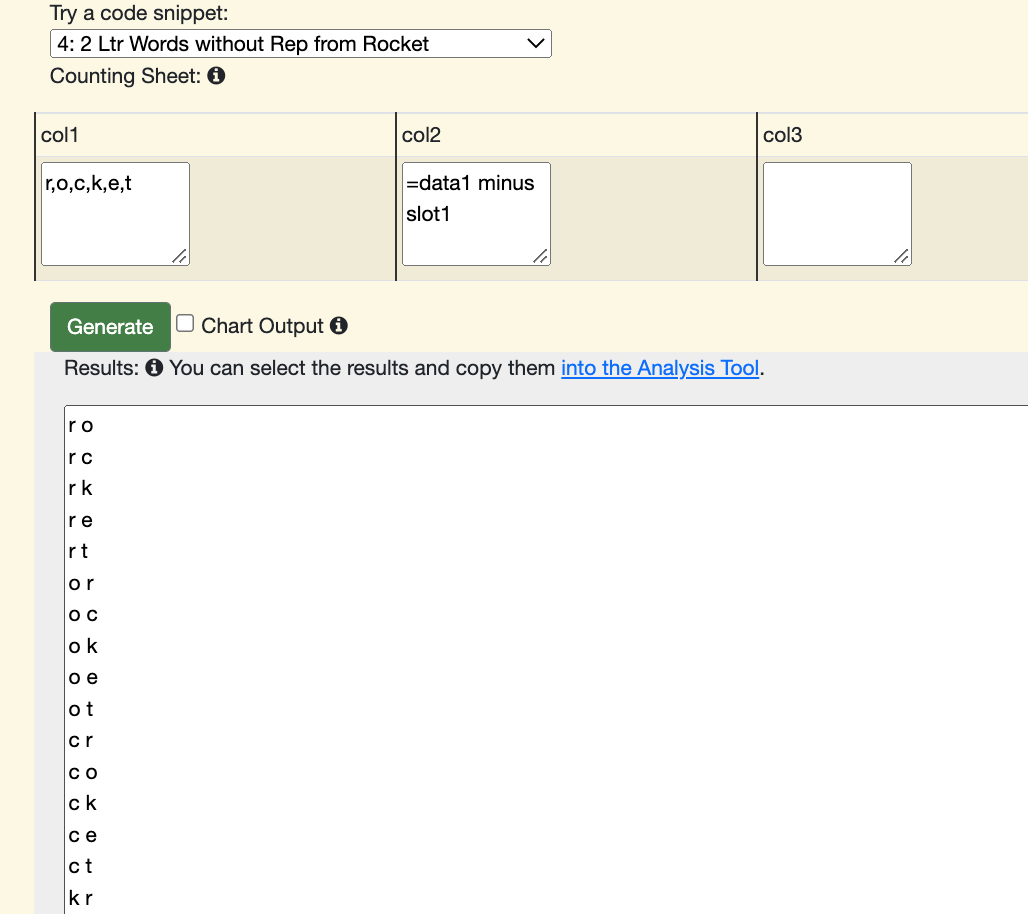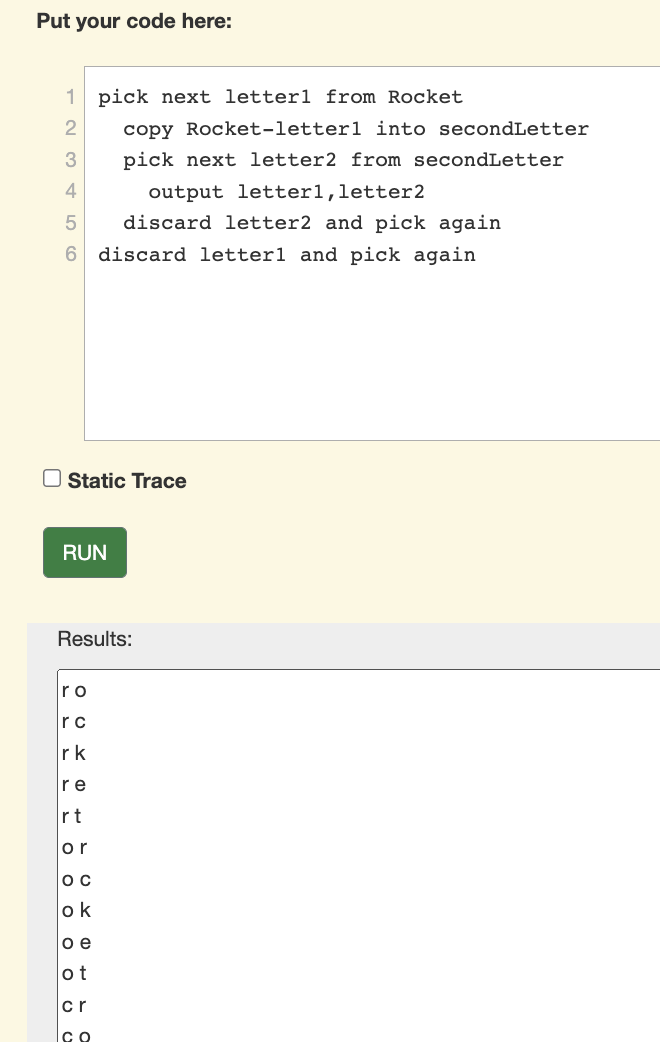Updates: NSF Funding to Study Learning with Teaspoon Languages for Discrete Mathematics
February 23, 2022 at 7:00 am 2 comments
A few months before the pandemic started, Dr. Elise Lockwood at Oregon State reached out to me. She’d heard that I was interested in programming for teaching non-CS subjects, and that’s what she was doing. I loved what she was doing, and we started having regular chats.
Elise is a mathematics education researcher who has been studying how students come to understand counting problems. Like “If you have three letters and four digits, how many license plates can you make?” Or “How many two letter words can you make from the letters ROCKET, if you don’t allow double letters?” She’s been exploring having students learn counting problems by manipulating Python programs to generate all the possible combinations, then counting them. (Check out her recent papers on her Google Scholar page, especially those with her student Adaline De Chenne.)
As I said, I loved what she was doing, but Python seemed heavy-handed for this. I was starting to work on our Teaspoon languages. Could we build lighter-weight languages for the same problems?
As I kept reading Elise’s papers, I started working on two possible designs.
In one of them (called Counting Sheets), we play off of students’ understanding of spreadsheets. You can just describe what you want in each column, and the system will exhaustively generate every combination:

Or you can use an “=“ formula that knows how to do very simple operations with sets. Here’s a solution to the two letter words from ROCKET without repeating problem:

This is one of the tools that we’ve been building in support for both Spanish and English keywords (like Pixel Equations, that I talked about last September):

Elise found Counting Sheets intriguing, but she was worried if it would work to make the iterative structures implicit and declarative. Would students need to see the iteration to be able to reason about the counting processes?
So, I built a second Teaspoon language, called Programmed Counting. Here, the loops are explicit, like Python, but the only variable type is a set, and the words and phrases of the language come from counting problems.

Elise was a real sport, trying out the languages as I generated prototypes and finding the holes in what I was doing. We met face-to-face only once, when I went to Portland for SIGCSE 2020 — the one that got cancelled the very morning it was supposed to start. I had lunch with Elise, and we worked for a few hours on the designs. Barb and I went home the next day, and the big pandemic lockdown started right afterwards.
Will these work for learning? We don’t know — but we just got funding from NSF to find out! “We” here is me and PhD student Emma Dodoo, and we’ll be involving Adaline as a consultant. Elise is currently a rotator at NSF, so she’s involved only from the sidelines because of NSF COI issues. Our plan is to run experiments with various combinations of the Teaspoon languages (one or both), standalone and with Python. Do we need Python if we have the Teaspoon languages? Do the Teaspoon languages serve as scaffolding to introduce concepts before starting into Python?
Below is the abstract on the new IUSE grant, as an overview of the project. University of Michigan CSE Communications wrote a nice article about the work, available here. Huge thanks to Jessie Houghton, Angela Li, and Derrick White who turned my LiveCode prototypes into functioning Web versions.
Abstract for NSF
Programming is a powerful tool that scientists, engineers, and mathematicians use to gain insight into their problems. Educators have shown how programming integrated into other subjects can be a powerful tool to enhance learning, from algebra to language arts. However, the cost is learning the programming language. Few students in the US learn programming — less than 5% of high school students nationwide. Most students do not have the opportunity to use programming to support ™ learning. This project is investigating a new approach to designing and implementing programming languages in classrooms: Task-specific programming (TSP) languages. TSP languages are explicitly design for integration in specific classes, to meet teacher needs, and to be usable with less than 10 minutes of instruction. TSP languages can make the power of programming to enhance learning more accessible. This project will test the value of TSP languages in discrete mathematics, which is a gateway course in some computer science programs.
The proposed project tests the use of two different TSP languages and contrasting that with a traditional programming language, Python. The proposed work will contribute to understanding about (1) the role of programming in learning in discrete mathematics, (2) the value of task-specific languages to scaffold learning, (3) how alternative representational forms for programming influence student use of TSP languages, and (4) how the use of TSP languages alone or in combination with traditional languages enhance students’ sense of authenticity and ability to transfer knowledge.
Entry filed under: Uncategorized. Tags: computing education research, mathematics education, Python, Teaspoon.
2 Comments Add your own
Leave a comment
Trackback this post | Subscribe to the comments via RSS Feed
1. Three types of computing education research: for CS, for CS but not professionally, and for everyone | Computing Education Research Blog | May 25, 2022 at 7:00 am
Three types of computing education research: for CS, for CS but not professionally, and for everyone | Computing Education Research Blog | May 25, 2022 at 7:00 am
[…] identify where I fit in that space. What I do these days (e.g. Teaspoon languages for history and mathematics classes) isn’t in the mainstream of computing education research, and it was important to tell […]
2. PCAS Expansion, Growth, Research, and SIGCSE 2024 Presentations | Computing Ed Research - Guzdial's Take | March 18, 2024 at 8:00 am
PCAS Expansion, Growth, Research, and SIGCSE 2024 Presentations | Computing Ed Research - Guzdial's Take | March 18, 2024 at 8:00 am
[…] 15:45 – 17:00 at Meeting Rooms E143-144, Tamara Nelson-Fromm is going to show where we are on our Discrete Mathematics project. She’ll demonstrate and share links to our ebooks for solving counting problems with Python and […]